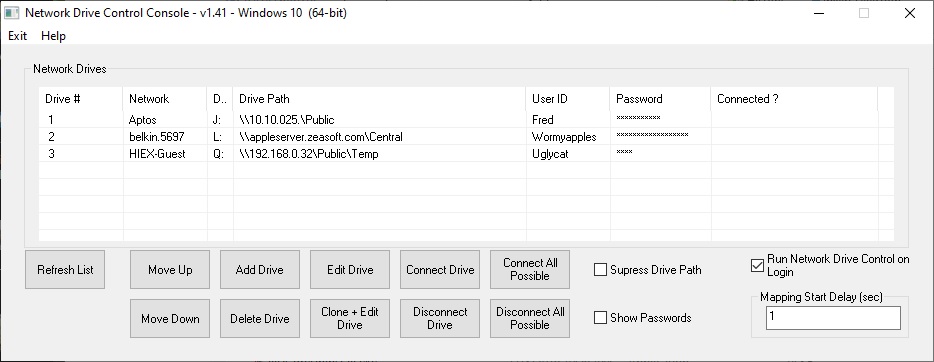
The purpose of NDC is to have Windows automatically map network drives by network name when you logon, just like Windows 7 could be made to set the default printer by network name.*
Windows Vista, 7, 8, 10 & 11

You are viewing this site from IP Address: 18.188.152.162
The above IP address is called: ec2-18-188-152-162.us-east-2.compute.amazonaws.com
You just came here from
[an error occurred while processing this directive]
copyright Michael J. Burns
v1.66 Release date March 9, 2024
Description:
Have Windows default mapping of network drives be network dependent, similar to how the Windows default printer can be set to be network dependent.
Network Drive Control (NDC) for Windows Vista, 7, 8, & 10, both 32-bit & 64-bit, and Windows 11, is an example of a utility I wrote to solve a frustrating problem I frequently encountered, namely wanting my network servers, both at work & home, mapped to Windows drives in a network specific manner. While one can tell Windows to try to map all of the drives at logon, I didn't like the long delays waiting for the time outs of the drive mapping for the networks that are not connected. (i.e. Waiting for the mapping of the home network drives to timeout when on my work network, and vice versa.) So I wrote my own utility which would examine the network environment after I logged in, and based on what network it found itself on, it would only attempt to map those drives it knew were on that network. Basically, I wanted the map network drives on login to function equivalently to the way the Windows 7 "default printer" did by being network specific. (Start → Devices and Printers → Manage Default Printers) The short of it is I wrote a modular program to do just that, and hence Network Drive Control was born.
Network Drive Control allows you to configure the automatic mapping of network drives when you logon based on the network(s) to which you are connected. An example would be to have your laptop automatically connect and map one set of network drives when at home, and another set of network drives when at work or school, and none if it detects that the PC is connected to a network where no mappings have been configured.
Network Drive Control has no limit to the number of networks or drives that can be configured (except Windows built in limits), and drive letters can be redundant. i.e. If on one network you like a resource to be mapped to drive, say, X:, and on a different network you'd like to have a different resource also mapped to X:, you can configure Network Drive Control to do so.
Network Drive Control utilizes Windows features built into Windows Vista through 10 (both 32-bit and 64-bit), and Windows 11, and supports drive mapping to a drive letter via Server Message Block (SMB), Common Internet File System (CIFS), Netbios, WebDAV, as well as map local directories to a drive letter. (Note: Windows does not natively support drive mapping to a drive letter via FTP, so neither does Network Drive Control. Windows only natively supports "network place" mappings via FTP, and those network place mappings do not have drive letters. There are commercial products out there that can map drive letters via FTP though custom drivers.)
Network Drive Control is free and has a built in help function. All binaries are signed, including the installer.
We add the usual warning that there are no warranties that this software will work correctly or will even run on your machine, and that you use it at your own risk.
Click here to download locally
- NDCSetup.zip
Click here to view the Release Notes
Click here to view an online version of the Help Files
Back to Michael Burns Software
Yes, Network Drive Control may be used completely free of charge, even when deploying in commercial organizations.
However if you wish to show your appreciation and support its development/hosting you can make a donation by clicking the PayPal button below.
Feedback, bug reports & feature requests can be sent to me at
*Yea, I know. Window 8-11 don't
have "Manage default printers" on the "Device and Printers -> Printers and
Faxes" toolbar like Windows 7 did, and Windows 10 &11 "Let Windows manage my
default printer" is problematic with it's constant changing of the default
printer to "last used" if you use multiple printers on a
given network.
I have written a utility called Network Printer Control
which allows you to have the network dependent default printer stay the network
dependent default and not keep switching to the "last used on that network"
on your Windows 8-11 systems.
https://www.networkdrivecontrol.com